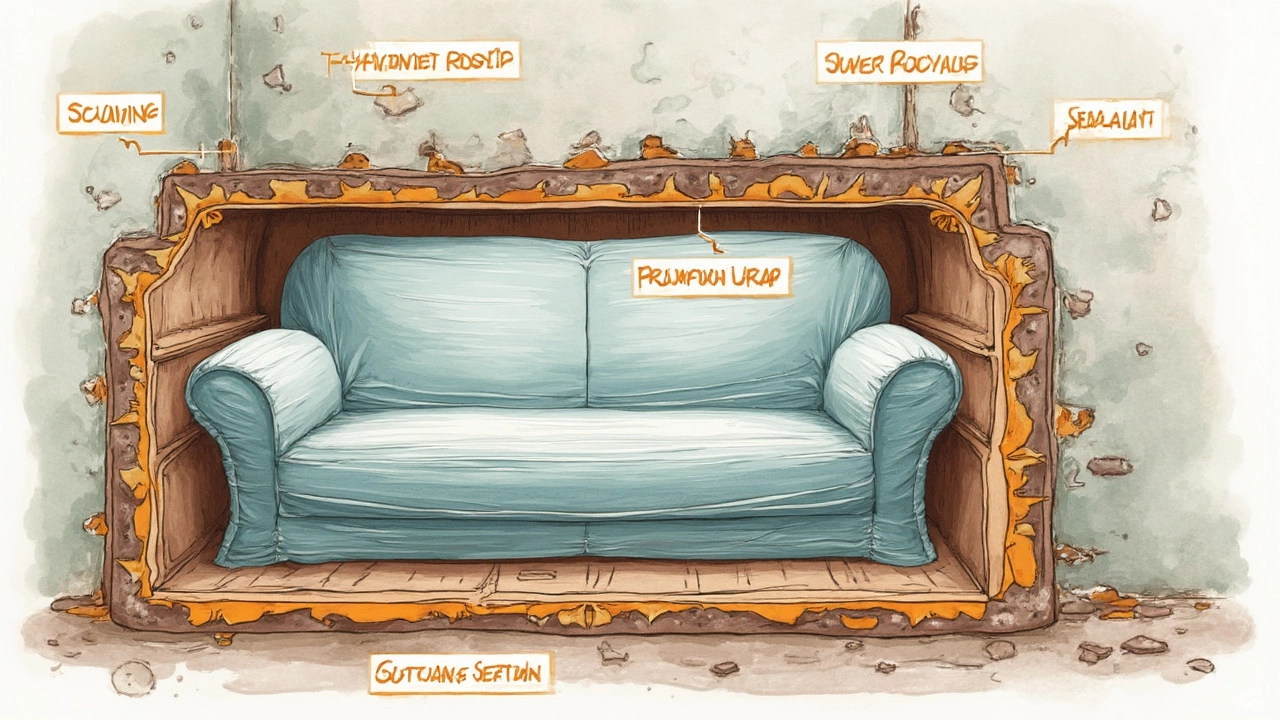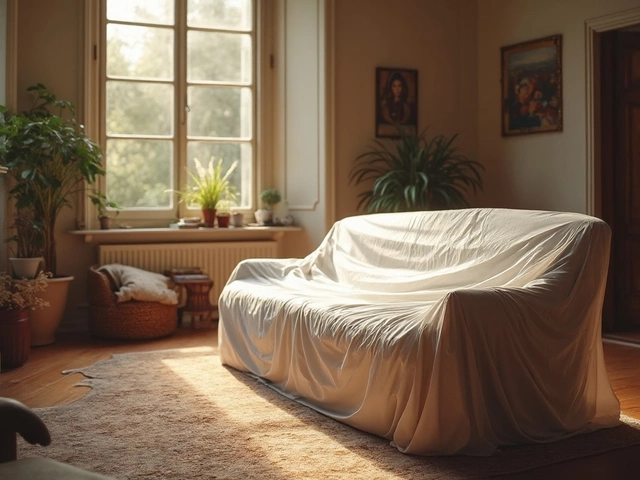Should You Wrap a Couch for Storage?

Storing your couch without any protection is like leaving your smartphone at a busy park—it's just asking for trouble. Wrapping a couch isn't just about keeping the fabric clean; it's about ensuring that when you finally pull it out of storage, it doesn't look like it's been through a dozen mud puddles. A couch, especially if it was an investment, deserves better than being thrown in a dark, dusty corner without a second thought.
You might think tossing a sheet over it will do the trick, but trust me, that’s not going to cut it. We’re talking about moisture sneaking in or little critters thinking your couch is their new condo. So, what's the game plan? You wrap it up, of course! But not just with any old thing—choosing the right materials can make all the difference. Bubble wrap, moving blankets, or those big rolls of shrink wrap you see at the hardware store are lifesavers when it comes to preserving your beloved couch.
Sure, it might sound like overkill, but when you’ve got a masterpiece like that plush sofa in the living room, taking extra steps now can save you from a horror show later. So, let’s dig into some tricks of the trade on how to wrap up that couch of yours properly.
- Understanding the Risks of Storage
- Types of Wrapping Materials
- Step-by-Step Wrapping Guide
- Common Mistakes to Avoid
- Maintaining Couch Quality During Storage
Understanding the Risks of Storage
So, you're thinking of tucking that couch away for a while? Before you do, let's chat about what your couch might face when it's sitting alone in storage. Left to its own devices, a couch can suffer from all sorts of damage—moisture, pests, dust, and even accidental bumps. It’s like a little adventure, just without the fun part.
Moisture is a biggie. If you're storing your couch in a place that isn't climate-controlled, like a garage or a storage unit, there's a good chance of dampness. Moisture can lead to mold or mildew, making your couch smell like a locker room. Not exactly what you want to enjoy when you finally bring it back home.
And then there's the danger of pests. Mice, bugs, and other critters seem to have it out for your furniture. To them, your couch could be a playground or even a snack. Wrapping the couch not only keeps critters at bay but also prevents them from calling your couch their new crib.
Dust might not sound so intimidating, but over time, it can wear down your couch's fabric and make it look ancient. Dust particles get into every nook and cranny, turning a vibrant couch into something that resembles an old rag.
- Moisture: Can cause mold and odors.
- Pests: Can lead to nesting or chewing damage.
- Dust: Dulls fabric and damages texture over time.
- Bumps and scratches: Unwrapped furniture is vulnerable during moving or within busy storage spaces.
Don’t forget, even the tiniest bumps can leave marks on your lovely couch. If it isn’t wrapped up, moving things around the storage unit could lead to scratches or even tears. Cushion covers and upholstery particularly are at risk. A small bump today can become a glaring tear tomorrow.
In short, storing a couch without thinking about these risks is like driving without a seatbelt. So, before you stash your couch away, seriously consider giving it the protection it deserves.
Types of Wrapping Materials
When it comes to storing your couch, choosing the right wrapping materials can mean the difference between pulling out a pristine piece and finding a sad, neglected mess. Not all materials are created equal, so knowing what works best is key. Let's break it down.
Bubble Wrap: This one's a classic. It's great for providing a protective cushioning layer. Its bubbles are like tiny airbags keeping your couch safe from scratches and dings. The downside? It's not breathable, so you don’t want it directly on fabrics for long periods. Use it as an outer layer.
Moving Blankets: Ever seen those thick, quilted blankets at your nearest moving supply store? They're perfect for covering your couch. These blankets are breathable, cushioned, and add a layer of protection against smudges and minor bumps. Plus, because they're soft, they won't scratch polished surfaces or delicate fabrics.
Shrink Wrap: This stuff you often see wrapped around pallets in warehouses. It's plastic and clingy, making it a good option for wrapping the whole couch tightly. But like bubble wrap, it's not breathable. It's great for keeping out dust and moisture as an outer layer. Make sure it's not the only thing touching your fabric.
Plastic Drop Cloths: Think of those see-through sheets often used in renovation projects. They're handy for keeping moisture and dust away but can trap moisture, too. Like shrink wrap, use it as a protective outer layer rather than directly on the couch.
Here's a quick snapshot of the main players:
| Material | Cost | Pros | Cons |
|---|---|---|---|
| Bubble Wrap | Moderate | Good protection, cushioning | Not breathable |
| Moving Blankets | Low to moderate | Breathable, protective | Can be bulky |
| Shrink Wrap | Low | Seals tight, dust-proof | Traps moisture |
| Plastic Drop Cloths | Very low | Inexpensive, moisture-resistant | Not breathable |
Choosing the right material depends on how long the couch will be in storage. Got a couple of months? Go easy with blankets. Planning on longer periods? Consider combining materials for extra layers of protection.

Step-by-Step Wrapping Guide
Alright, you've decided to store your couch and now it's time to get serious about wrapping it up right. Let’s break it down step-by-step so you can ensure your couch is well protected and ready for its temporary hibernation.
- Clean the Couch Thoroughly: Nobody wants to trap dirt and grime under the wrap. Vacuum the couch, get into those crevices where crumbs like to hide, and if necessary, use a fabric cleaner for any stains.
- Disassemble What You Can: If your couch has removable legs or cushions, take them off. It’ll make wrapping easier and help maximize storage space.
- Choose Your Wrapping Materials: Go for moving blankets or bubble wrap. Moving blankets are great for padding and protection, while bubble wrap gives that added moisture defense.
- Wrap the Cushions and Legs Separately: Tackle those removable parts one at a time. They should be wrapped individually and securely to prevent any scuffs or damage.
- Cover the Entire Couch: Start by laying blankets or bubble wrap over the main body of the couch. Make sure it's covered top to bottom and tightly secured, but don’t wrap so tight you damage the shape.
- Secure Wrap with Packing Tape: Use some solid packing tape to ensure everything stays put. Just be mindful not to tape directly on any fabric—it might leave a sticky mess when removed.
- Consider a Plastic Wrap Overlayer: If you're worried about water or pest damage, a layer of plastic shrink wrap can give you peace of mind.
And there you have it! With this wrapping method, your couch storage game will be on point. No smarty will mistake your stored couch for a dusty relic when you're ready to bring it back to life.
Common Mistakes to Avoid
When it comes to storing a couch, mistakes happen. We all slip up now and then, but knowing the common pitfalls can save you headaches down the line. Let's break down those missteps that people often make and how to dodge them.
First up, forgetting to clean the couch before wrapping it. Sounds basic, right? But you'd be surprised how often folks skip this step. A bit of leftover snack crumbs might not seem like a big deal until they attract a whole party of ants. Always vacuum every nook and cranny before wrapping it up.
Next, choosing the wrong wrapping material. I've seen people use old bed sheets thinking it'll do the job. Big mistake! A sheet might keep dust at bay, but it's not going to prevent moisture damage or block pests. Instead, go for heavy-duty plastic or furniture-specific covers, and for an extra layer, use moving blankets.
Another common error is not labeling parts. If your couch comes apart in sections, label each piece. You'll thank yourself when reassembling later, especially if you've stored more than one item. Grab some masking tape and jot down quick notes if needed.
Speaking of storage spots, placing a couch directly on the storage unit floor can cause problems if unexpected moisture seeps in. Put down a plastic sheet or pallets to elevate it a little. This simple hack can protect it from dampness and unexpected spills.
Lastly, don't seal the couch too tightly. While it's important to protect against moisture, a completely airtight wrap can lead to mildew—gross! Allow for some air circulation.
By steering clear of these common mistakes, you can keep your couch looking as good as new while it patiently waits for its comeback.

Maintaining Couch Quality During Storage
Alright, so you've gone through the trouble to wrap your couch for storage, thinking that's the end of the story. Not quite! Keeping your couch in mint condition while it’s tucked away involves a bit more effort. Here's how you can make sure it comes out looking as good as it went in.
First, always choose the right spot for storage. Basements and attics might be tempting, but they often have a sneaky habit of fluctuating temperatures and humidity levels. These changes can lead to mold and mildew. Try to use a climate-controlled storage unit if possible—that’s the gold standard. If you’re stashing it at home, find a stable environment where the temperature doesn’t swing dramatically.
Next, elevate the couch. Sounds fancy, right? But all it means is getting your couch off the ground a bit. This step helps keep away unwanted pests and avoids potential water damage from minor floods or leaks. Place pallets or bricks beneath it, or even just construct a makeshift platform with sturdy boxes.
And it's not all about just keeping things off. Give it some breathing room, too. Allow air to circulate around and under the couch. Don't stack boxes or other items directly on top of your wrapped couch. That way, you won't come back to find any unexpected dents or deformations in the cushions.
Lastly, do occasional check-ins, especially if the couch is stored nearby. Take a peek every few months to ensure there’s no damage, pests, or moisture building up. If you’ve wrapped it in shrink wrap, make sure it hasn't torn. Better to catch issues early than to be greeted by unpleasant surprises!
If this sounds like a lot, don't sweat it; these small steps can seriously save you the headache—and the cost—of expensive repairs or replacements. Plus, you'll thank yourself when it's time to reunite with that comfy couch without any regrets!
